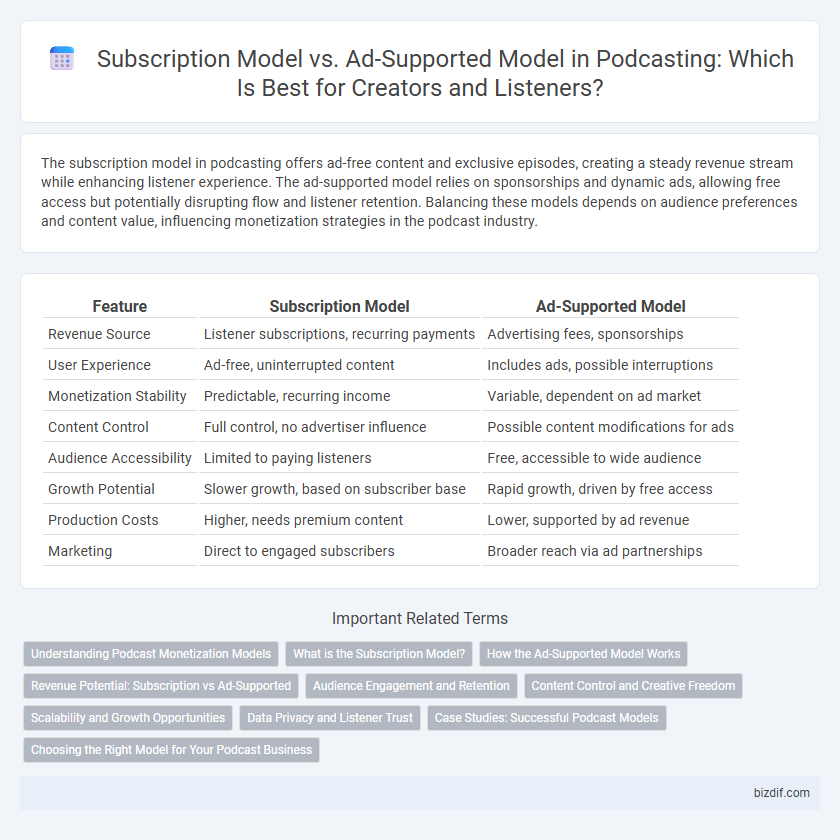The subscription model in podcasting offers ad-free content and exclusive episodes, creating a steady revenue stream while enhancing listener experience. The ad-supported model relies on sponsorships and dynamic ads, allowing free access but potentially disrupting flow and listener retention. Balancing these models depends on audience preferences and content value, influencing monetization strategies in the podcast industry.
Table of Comparison
| Feature | Subscription Model | Ad-Supported Model |
|---|---|---|
| Revenue Source | Listener subscriptions, recurring payments | Advertising fees, sponsorships |
| User Experience | Ad-free, uninterrupted content | Includes ads, possible interruptions |
| Monetization Stability | Predictable, recurring income | Variable, dependent on ad market |
| Content Control | Full control, no advertiser influence | Possible content modifications for ads |
| Audience Accessibility | Limited to paying listeners | Free, accessible to wide audience |
| Growth Potential | Slower growth, based on subscriber base | Rapid growth, driven by free access |
| Production Costs | Higher, needs premium content | Lower, supported by ad revenue |
| Marketing | Direct to engaged subscribers | Broader reach via ad partnerships |
Understanding Podcast Monetization Models
Podcast monetization primarily revolves around subscription and ad-supported models, each offering distinct revenue streams and audience experiences. Subscription models generate consistent income through listener payments, often providing ad-free content or exclusive episodes, enhancing listener loyalty and engagement. Ad-supported models rely on dynamic advertising, allowing free access while attracting sponsors based on audience size and demographics, optimizing revenue through targeted marketing campaigns.
What is the Subscription Model?
The subscription model in podcasting involves listeners paying a recurring fee to access exclusive content, ad-free episodes, or premium features, ensuring a steady revenue stream for creators. This model appeals to loyal audiences seeking uninterrupted listening experiences and deeper engagement with podcast material. Subscription platforms like Patreon and Apple Podcasts Subscriptions enable creators to monetize directly without relying on fluctuating ad revenues.
How the Ad-Supported Model Works
The ad-supported podcast model generates revenue by integrating advertisements directly into podcast episodes, typically as pre-roll, mid-roll, or post-roll ads that play during the listening experience. Advertisers pay podcasters based on metrics like downloads, impressions, or listener engagement, enabling content creators to offer free episodes to a broad audience while monetizing their reach. This model relies heavily on targeted advertising and listener demographics to maximize ad relevance and effectiveness, driving sustainable income for podcasters.
Revenue Potential: Subscription vs Ad-Supported
Subscription models generate steady, predictable revenue by charging listeners a recurring fee, often resulting in higher lifetime value per user compared to ad-supported models. Ad-supported podcasts rely on dynamic ad insertions and audience size to drive income, which can fluctuate with listener engagement and market demand. Monetizing through subscriptions provides direct financial support and reduces dependence on advertiser budgets, whereas ad-supported podcasts benefit from broader accessibility but variable revenue streams.
Audience Engagement and Retention
The subscription model fosters deeper audience engagement by offering ad-free, exclusive content that encourages long-term listener loyalty and reduces churn rates. Conversely, the ad-supported model attracts a broader audience through free access but may experience lower retention due to interruptions and listener fatigue from frequent ads. Data shows subscription podcasts often achieve 30-50% higher listener retention compared to ad-supported counterparts, highlighting the impact of content delivery approach on sustained audience growth.
Content Control and Creative Freedom
Subscription models in podcasting provide creators with greater content control and enhanced creative freedom by removing reliance on advertiser demands and allowing unfiltered expression. Ad-supported models often require content adjustments to meet advertiser guidelines, potentially limiting the scope and authenticity of podcast topics. This direct financial relationship with listeners in subscription setups fosters more innovative and niche content tailored to dedicated audiences.
Scalability and Growth Opportunities
The subscription model in podcasting offers predictable revenue streams and higher monetization potential per user, enabling scalable growth through targeted premium content and loyal audience retention. In contrast, the ad-supported model relies on larger listener bases to maximize revenue, presenting scalability tied to audience size and advertiser demand fluctuations. Combining both models can optimize growth opportunities by balancing steady income and expansive reach in diverse market conditions.
Data Privacy and Listener Trust
Subscription models in podcasting enhance data privacy by minimizing third-party access to listener information, fostering greater trust among subscribers. Ad-supported models often require extensive data collection to target advertisements effectively, raising concerns about personal data exploitation and potential breaches of listener trust. Prioritizing transparent data practices and user consent is crucial for podcasters seeking to balance revenue generation with maintaining listener confidence.
Case Studies: Successful Podcast Models
Spotify's adoption of a mixed podcasting revenue model highlights the effectiveness of combining subscription and ad-supported formats, boasting over 4 million premium subscribers and generating significant ad revenue through targeted campaigns. Gimlet Media's success story emphasizes a subscription approach, leveraging exclusive content to build a loyal audience and achieving substantial listener engagement before its acquisition by Spotify. Conversely, The Joe Rogan Experience, thriving primarily on ad-supported content, demonstrates the potential for high revenue through sponsorship deals and massive listener bases exceeding 190 million downloads per episode.
Choosing the Right Model for Your Podcast Business
Choosing the right model for your podcast business involves evaluating audience size, engagement levels, and revenue goals. Subscription models provide steady, predictable income through listener payments, ideal for niche content with loyal audiences. Ad-supported models rely on high listener volume and effective ad placements, offering scalability and broader reach for podcasts with mass appeal.
Subscription model vs Ad-supported model Infographic

 bizdif.com
bizdif.com